Information Technology Report: Hyperloop One as a Disruptive Force
VerifiedAdded on 2023/06/12
|9
|1871
|426
Report
AI Summary
This report examines Hyperloop One as a disruptive technology poised to revolutionize transportation. It details the technology's historical context, tracing transportation evolution from early animal-powered methods to modern air travel. It highlights the technical aspects of Hyperloop, including its vacuum tube system, power requirements, and potential speeds exceeding air travel. The report further analyzes the potential economic and societal impacts, noting benefits like reduced travel times and transportation costs while also acknowledging potential risks. It concludes that while initial implementation costs may be high, Hyperloop has the potential to replace traditional rail and road transport, provided that thorough testing and preventative measures are implemented.
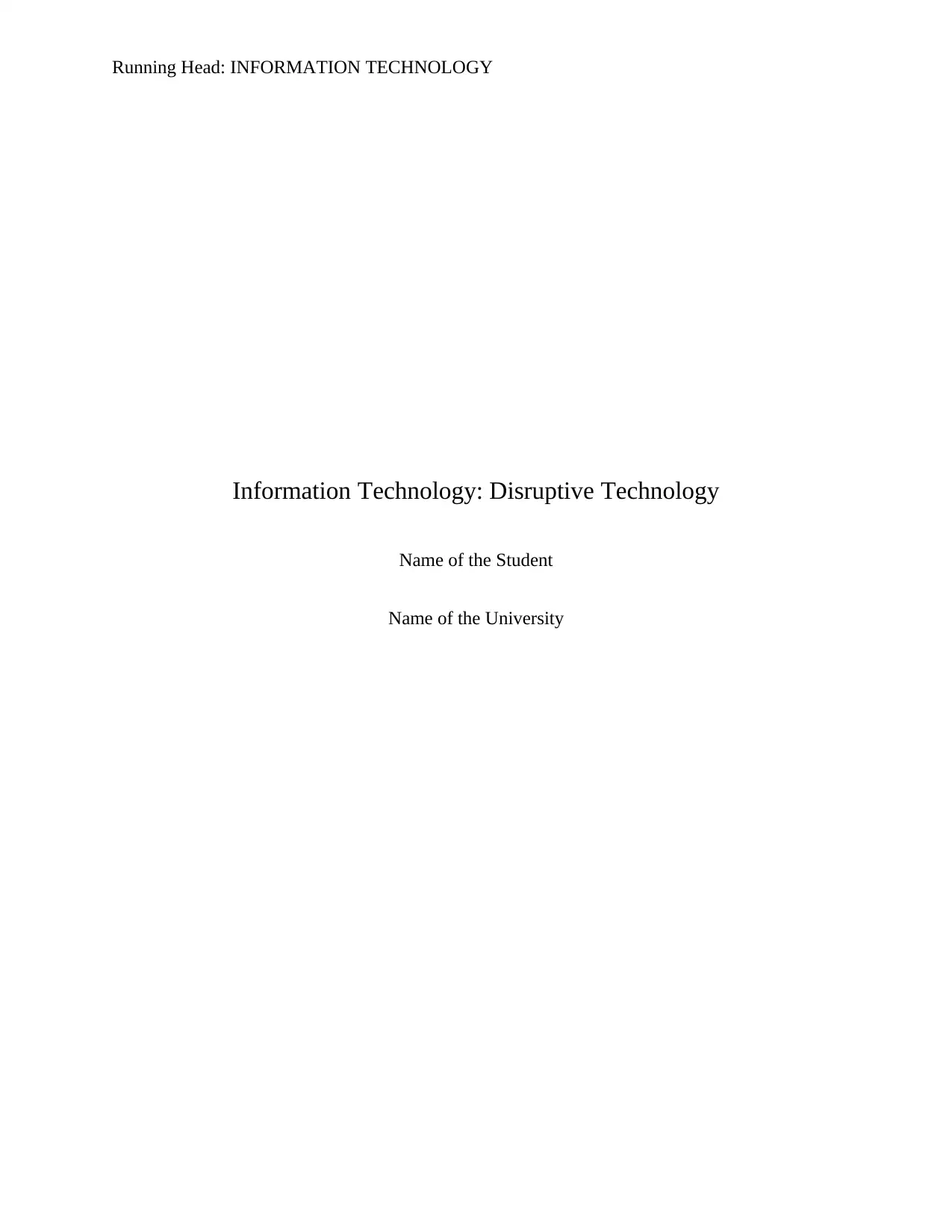
Running Head: INFORMATION TECHNOLOGY
Information Technology: Disruptive Technology
Name of the Student
Name of the University
Information Technology: Disruptive Technology
Name of the Student
Name of the University
Paraphrase This Document
Need a fresh take? Get an instant paraphrase of this document with our AI Paraphraser
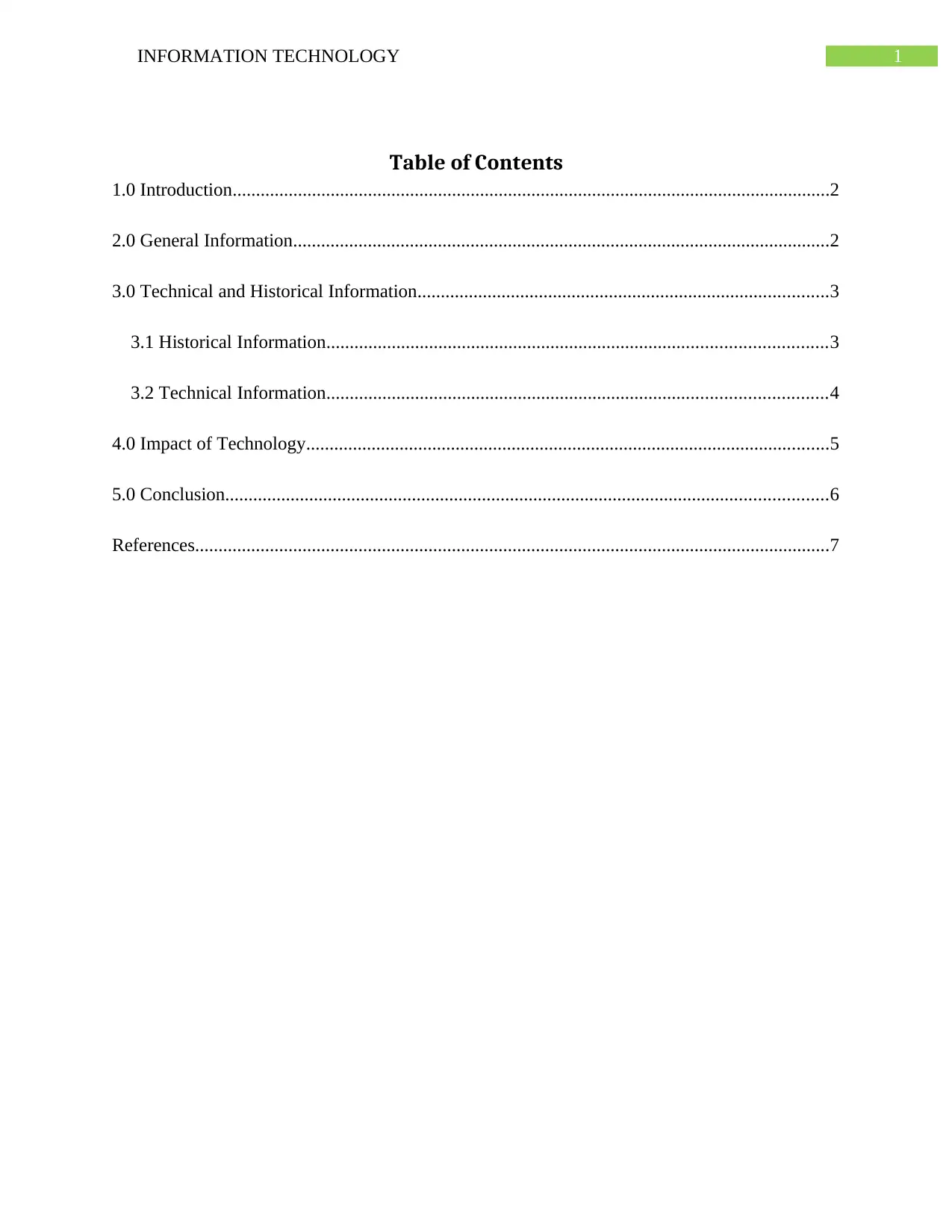
1INFORMATION TECHNOLOGY
Table of Contents
1.0 Introduction................................................................................................................................2
2.0 General Information...................................................................................................................2
3.0 Technical and Historical Information........................................................................................3
3.1 Historical Information...........................................................................................................3
3.2 Technical Information...........................................................................................................4
4.0 Impact of Technology................................................................................................................5
5.0 Conclusion.................................................................................................................................6
References........................................................................................................................................7
Table of Contents
1.0 Introduction................................................................................................................................2
2.0 General Information...................................................................................................................2
3.0 Technical and Historical Information........................................................................................3
3.1 Historical Information...........................................................................................................3
3.2 Technical Information...........................................................................................................4
4.0 Impact of Technology................................................................................................................5
5.0 Conclusion.................................................................................................................................6
References........................................................................................................................................7
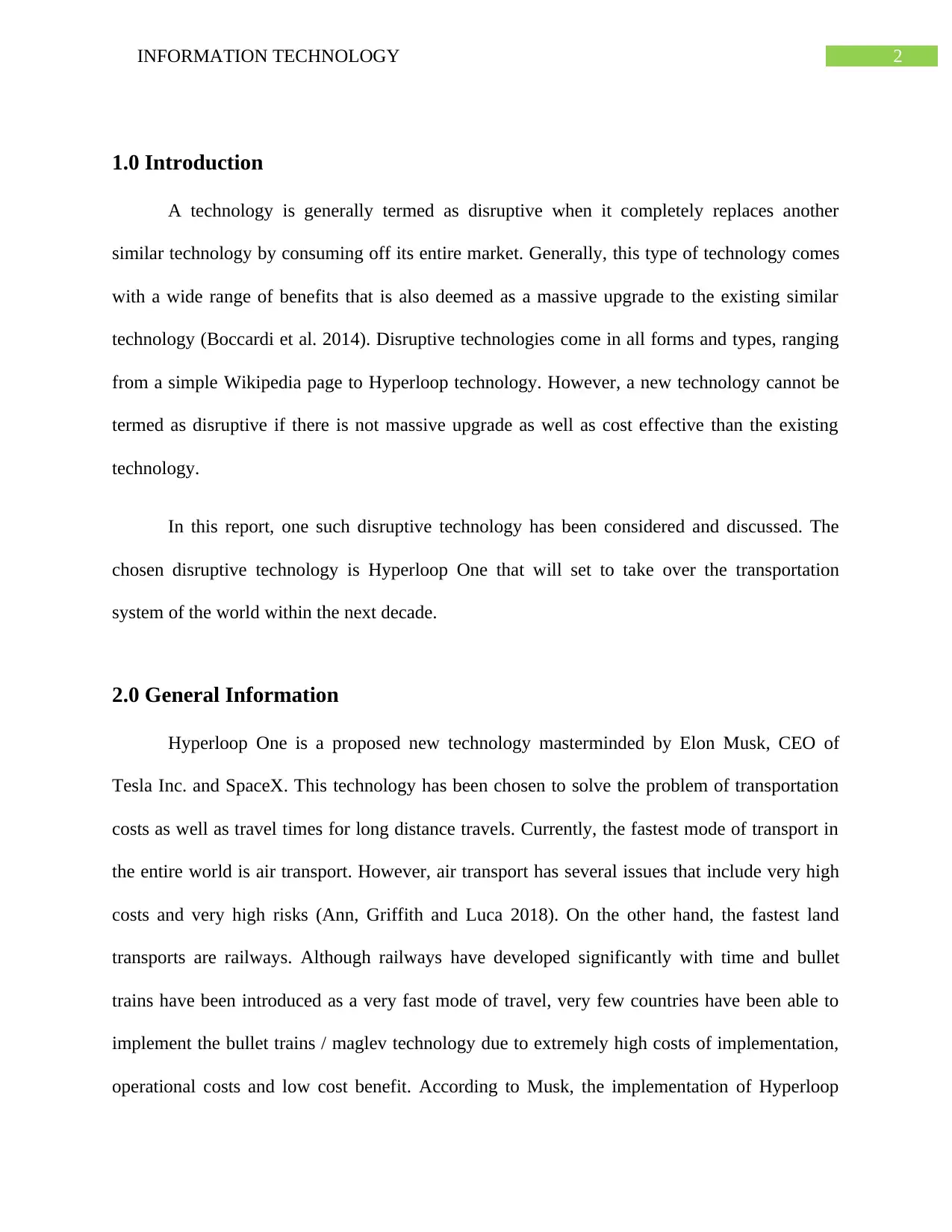
2INFORMATION TECHNOLOGY
1.0 Introduction
A technology is generally termed as disruptive when it completely replaces another
similar technology by consuming off its entire market. Generally, this type of technology comes
with a wide range of benefits that is also deemed as a massive upgrade to the existing similar
technology (Boccardi et al. 2014). Disruptive technologies come in all forms and types, ranging
from a simple Wikipedia page to Hyperloop technology. However, a new technology cannot be
termed as disruptive if there is not massive upgrade as well as cost effective than the existing
technology.
In this report, one such disruptive technology has been considered and discussed. The
chosen disruptive technology is Hyperloop One that will set to take over the transportation
system of the world within the next decade.
2.0 General Information
Hyperloop One is a proposed new technology masterminded by Elon Musk, CEO of
Tesla Inc. and SpaceX. This technology has been chosen to solve the problem of transportation
costs as well as travel times for long distance travels. Currently, the fastest mode of transport in
the entire world is air transport. However, air transport has several issues that include very high
costs and very high risks (Ann, Griffith and Luca 2018). On the other hand, the fastest land
transports are railways. Although railways have developed significantly with time and bullet
trains have been introduced as a very fast mode of travel, very few countries have been able to
implement the bullet trains / maglev technology due to extremely high costs of implementation,
operational costs and low cost benefit. According to Musk, the implementation of Hyperloop
1.0 Introduction
A technology is generally termed as disruptive when it completely replaces another
similar technology by consuming off its entire market. Generally, this type of technology comes
with a wide range of benefits that is also deemed as a massive upgrade to the existing similar
technology (Boccardi et al. 2014). Disruptive technologies come in all forms and types, ranging
from a simple Wikipedia page to Hyperloop technology. However, a new technology cannot be
termed as disruptive if there is not massive upgrade as well as cost effective than the existing
technology.
In this report, one such disruptive technology has been considered and discussed. The
chosen disruptive technology is Hyperloop One that will set to take over the transportation
system of the world within the next decade.
2.0 General Information
Hyperloop One is a proposed new technology masterminded by Elon Musk, CEO of
Tesla Inc. and SpaceX. This technology has been chosen to solve the problem of transportation
costs as well as travel times for long distance travels. Currently, the fastest mode of transport in
the entire world is air transport. However, air transport has several issues that include very high
costs and very high risks (Ann, Griffith and Luca 2018). On the other hand, the fastest land
transports are railways. Although railways have developed significantly with time and bullet
trains have been introduced as a very fast mode of travel, very few countries have been able to
implement the bullet trains / maglev technology due to extremely high costs of implementation,
operational costs and low cost benefit. According to Musk, the implementation of Hyperloop
⊘ This is a preview!⊘
Do you want full access?
Subscribe today to unlock all pages.

Trusted by 1+ million students worldwide
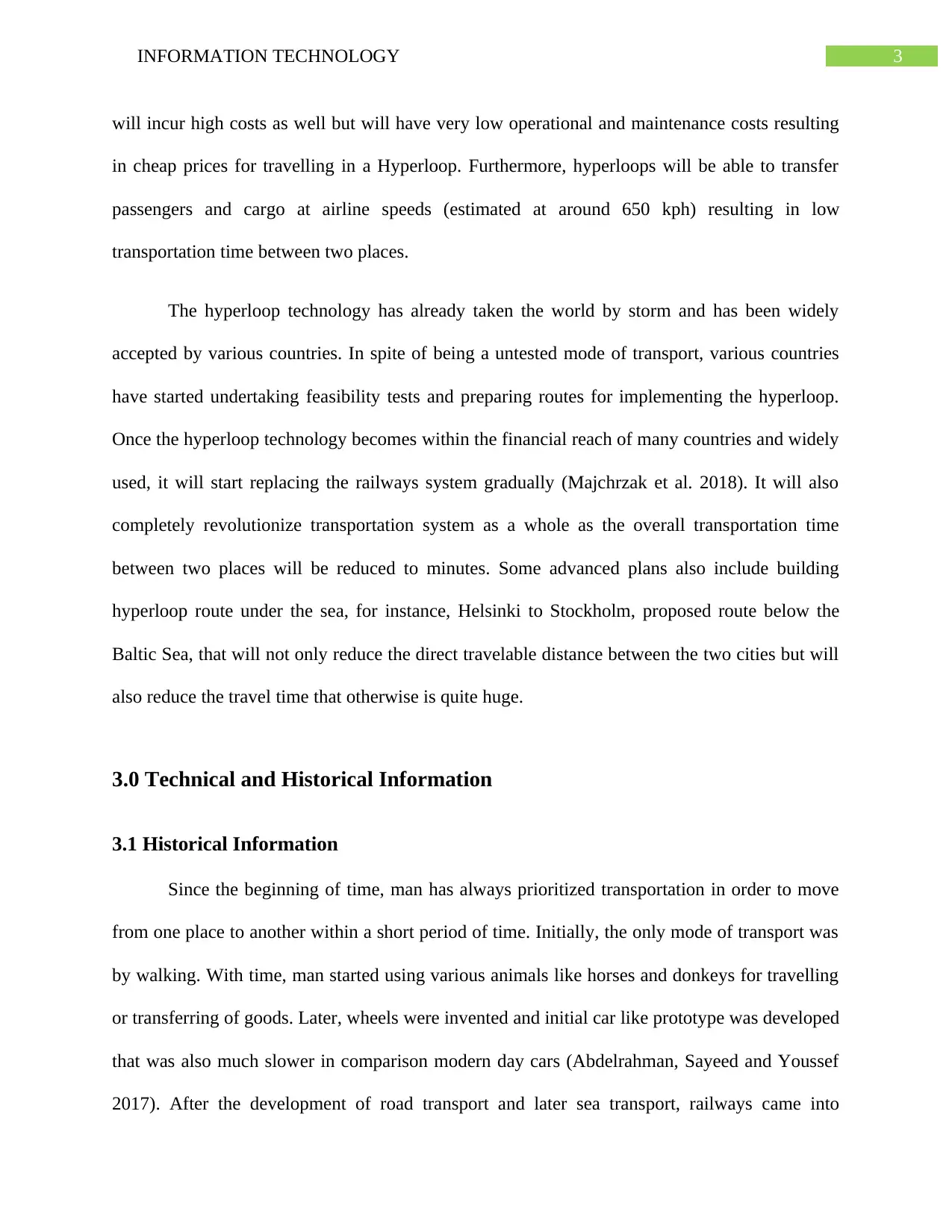
3INFORMATION TECHNOLOGY
will incur high costs as well but will have very low operational and maintenance costs resulting
in cheap prices for travelling in a Hyperloop. Furthermore, hyperloops will be able to transfer
passengers and cargo at airline speeds (estimated at around 650 kph) resulting in low
transportation time between two places.
The hyperloop technology has already taken the world by storm and has been widely
accepted by various countries. In spite of being a untested mode of transport, various countries
have started undertaking feasibility tests and preparing routes for implementing the hyperloop.
Once the hyperloop technology becomes within the financial reach of many countries and widely
used, it will start replacing the railways system gradually (Majchrzak et al. 2018). It will also
completely revolutionize transportation system as a whole as the overall transportation time
between two places will be reduced to minutes. Some advanced plans also include building
hyperloop route under the sea, for instance, Helsinki to Stockholm, proposed route below the
Baltic Sea, that will not only reduce the direct travelable distance between the two cities but will
also reduce the travel time that otherwise is quite huge.
3.0 Technical and Historical Information
3.1 Historical Information
Since the beginning of time, man has always prioritized transportation in order to move
from one place to another within a short period of time. Initially, the only mode of transport was
by walking. With time, man started using various animals like horses and donkeys for travelling
or transferring of goods. Later, wheels were invented and initial car like prototype was developed
that was also much slower in comparison modern day cars (Abdelrahman, Sayeed and Youssef
2017). After the development of road transport and later sea transport, railways came into
will incur high costs as well but will have very low operational and maintenance costs resulting
in cheap prices for travelling in a Hyperloop. Furthermore, hyperloops will be able to transfer
passengers and cargo at airline speeds (estimated at around 650 kph) resulting in low
transportation time between two places.
The hyperloop technology has already taken the world by storm and has been widely
accepted by various countries. In spite of being a untested mode of transport, various countries
have started undertaking feasibility tests and preparing routes for implementing the hyperloop.
Once the hyperloop technology becomes within the financial reach of many countries and widely
used, it will start replacing the railways system gradually (Majchrzak et al. 2018). It will also
completely revolutionize transportation system as a whole as the overall transportation time
between two places will be reduced to minutes. Some advanced plans also include building
hyperloop route under the sea, for instance, Helsinki to Stockholm, proposed route below the
Baltic Sea, that will not only reduce the direct travelable distance between the two cities but will
also reduce the travel time that otherwise is quite huge.
3.0 Technical and Historical Information
3.1 Historical Information
Since the beginning of time, man has always prioritized transportation in order to move
from one place to another within a short period of time. Initially, the only mode of transport was
by walking. With time, man started using various animals like horses and donkeys for travelling
or transferring of goods. Later, wheels were invented and initial car like prototype was developed
that was also much slower in comparison modern day cars (Abdelrahman, Sayeed and Youssef
2017). After the development of road transport and later sea transport, railways came into
Paraphrase This Document
Need a fresh take? Get an instant paraphrase of this document with our AI Paraphraser
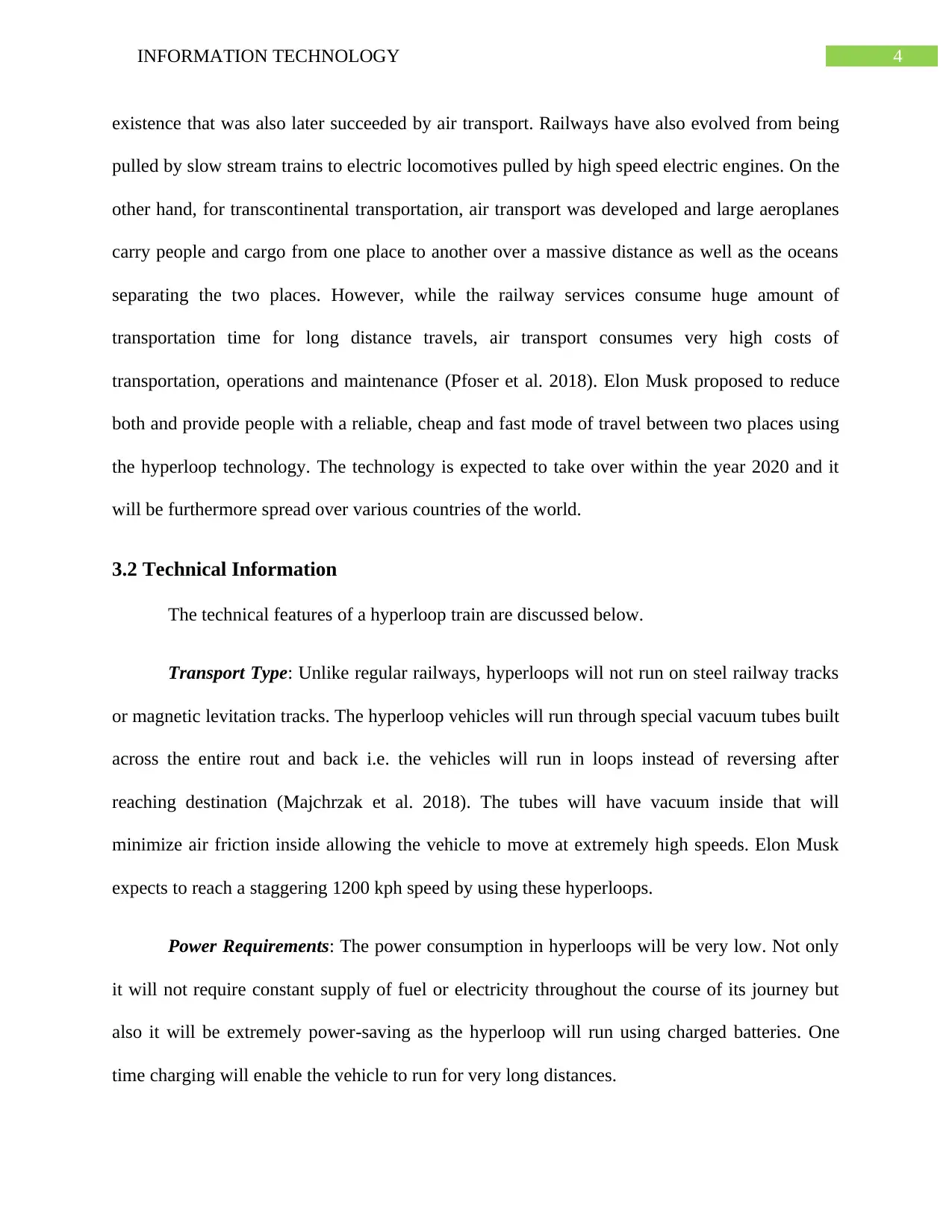
4INFORMATION TECHNOLOGY
existence that was also later succeeded by air transport. Railways have also evolved from being
pulled by slow stream trains to electric locomotives pulled by high speed electric engines. On the
other hand, for transcontinental transportation, air transport was developed and large aeroplanes
carry people and cargo from one place to another over a massive distance as well as the oceans
separating the two places. However, while the railway services consume huge amount of
transportation time for long distance travels, air transport consumes very high costs of
transportation, operations and maintenance (Pfoser et al. 2018). Elon Musk proposed to reduce
both and provide people with a reliable, cheap and fast mode of travel between two places using
the hyperloop technology. The technology is expected to take over within the year 2020 and it
will be furthermore spread over various countries of the world.
3.2 Technical Information
The technical features of a hyperloop train are discussed below.
Transport Type: Unlike regular railways, hyperloops will not run on steel railway tracks
or magnetic levitation tracks. The hyperloop vehicles will run through special vacuum tubes built
across the entire rout and back i.e. the vehicles will run in loops instead of reversing after
reaching destination (Majchrzak et al. 2018). The tubes will have vacuum inside that will
minimize air friction inside allowing the vehicle to move at extremely high speeds. Elon Musk
expects to reach a staggering 1200 kph speed by using these hyperloops.
Power Requirements: The power consumption in hyperloops will be very low. Not only
it will not require constant supply of fuel or electricity throughout the course of its journey but
also it will be extremely power-saving as the hyperloop will run using charged batteries. One
time charging will enable the vehicle to run for very long distances.
existence that was also later succeeded by air transport. Railways have also evolved from being
pulled by slow stream trains to electric locomotives pulled by high speed electric engines. On the
other hand, for transcontinental transportation, air transport was developed and large aeroplanes
carry people and cargo from one place to another over a massive distance as well as the oceans
separating the two places. However, while the railway services consume huge amount of
transportation time for long distance travels, air transport consumes very high costs of
transportation, operations and maintenance (Pfoser et al. 2018). Elon Musk proposed to reduce
both and provide people with a reliable, cheap and fast mode of travel between two places using
the hyperloop technology. The technology is expected to take over within the year 2020 and it
will be furthermore spread over various countries of the world.
3.2 Technical Information
The technical features of a hyperloop train are discussed below.
Transport Type: Unlike regular railways, hyperloops will not run on steel railway tracks
or magnetic levitation tracks. The hyperloop vehicles will run through special vacuum tubes built
across the entire rout and back i.e. the vehicles will run in loops instead of reversing after
reaching destination (Majchrzak et al. 2018). The tubes will have vacuum inside that will
minimize air friction inside allowing the vehicle to move at extremely high speeds. Elon Musk
expects to reach a staggering 1200 kph speed by using these hyperloops.
Power Requirements: The power consumption in hyperloops will be very low. Not only
it will not require constant supply of fuel or electricity throughout the course of its journey but
also it will be extremely power-saving as the hyperloop will run using charged batteries. One
time charging will enable the vehicle to run for very long distances.
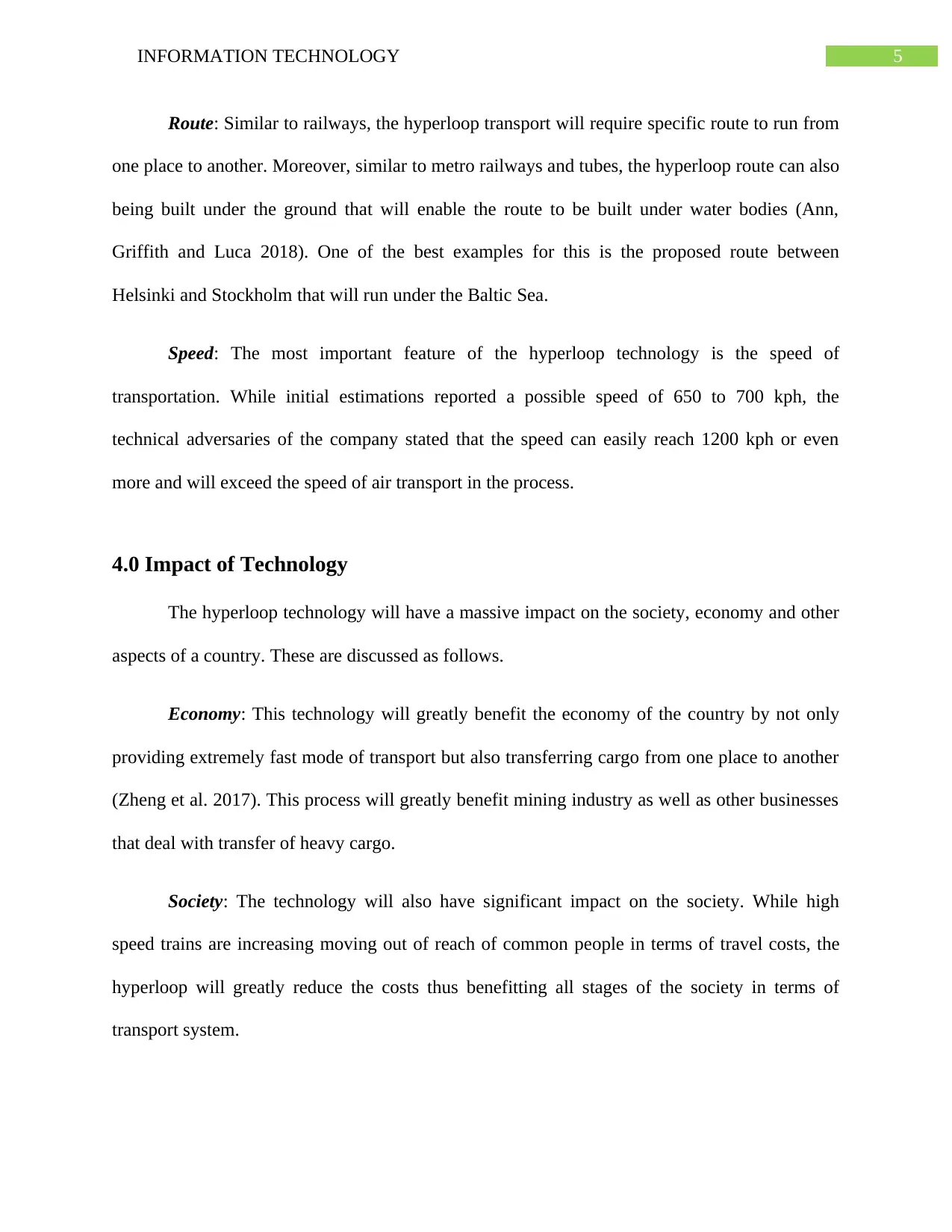
5INFORMATION TECHNOLOGY
Route: Similar to railways, the hyperloop transport will require specific route to run from
one place to another. Moreover, similar to metro railways and tubes, the hyperloop route can also
being built under the ground that will enable the route to be built under water bodies (Ann,
Griffith and Luca 2018). One of the best examples for this is the proposed route between
Helsinki and Stockholm that will run under the Baltic Sea.
Speed: The most important feature of the hyperloop technology is the speed of
transportation. While initial estimations reported a possible speed of 650 to 700 kph, the
technical adversaries of the company stated that the speed can easily reach 1200 kph or even
more and will exceed the speed of air transport in the process.
4.0 Impact of Technology
The hyperloop technology will have a massive impact on the society, economy and other
aspects of a country. These are discussed as follows.
Economy: This technology will greatly benefit the economy of the country by not only
providing extremely fast mode of transport but also transferring cargo from one place to another
(Zheng et al. 2017). This process will greatly benefit mining industry as well as other businesses
that deal with transfer of heavy cargo.
Society: The technology will also have significant impact on the society. While high
speed trains are increasing moving out of reach of common people in terms of travel costs, the
hyperloop will greatly reduce the costs thus benefitting all stages of the society in terms of
transport system.
Route: Similar to railways, the hyperloop transport will require specific route to run from
one place to another. Moreover, similar to metro railways and tubes, the hyperloop route can also
being built under the ground that will enable the route to be built under water bodies (Ann,
Griffith and Luca 2018). One of the best examples for this is the proposed route between
Helsinki and Stockholm that will run under the Baltic Sea.
Speed: The most important feature of the hyperloop technology is the speed of
transportation. While initial estimations reported a possible speed of 650 to 700 kph, the
technical adversaries of the company stated that the speed can easily reach 1200 kph or even
more and will exceed the speed of air transport in the process.
4.0 Impact of Technology
The hyperloop technology will have a massive impact on the society, economy and other
aspects of a country. These are discussed as follows.
Economy: This technology will greatly benefit the economy of the country by not only
providing extremely fast mode of transport but also transferring cargo from one place to another
(Zheng et al. 2017). This process will greatly benefit mining industry as well as other businesses
that deal with transfer of heavy cargo.
Society: The technology will also have significant impact on the society. While high
speed trains are increasing moving out of reach of common people in terms of travel costs, the
hyperloop will greatly reduce the costs thus benefitting all stages of the society in terms of
transport system.
⊘ This is a preview!⊘
Do you want full access?
Subscribe today to unlock all pages.

Trusted by 1+ million students worldwide
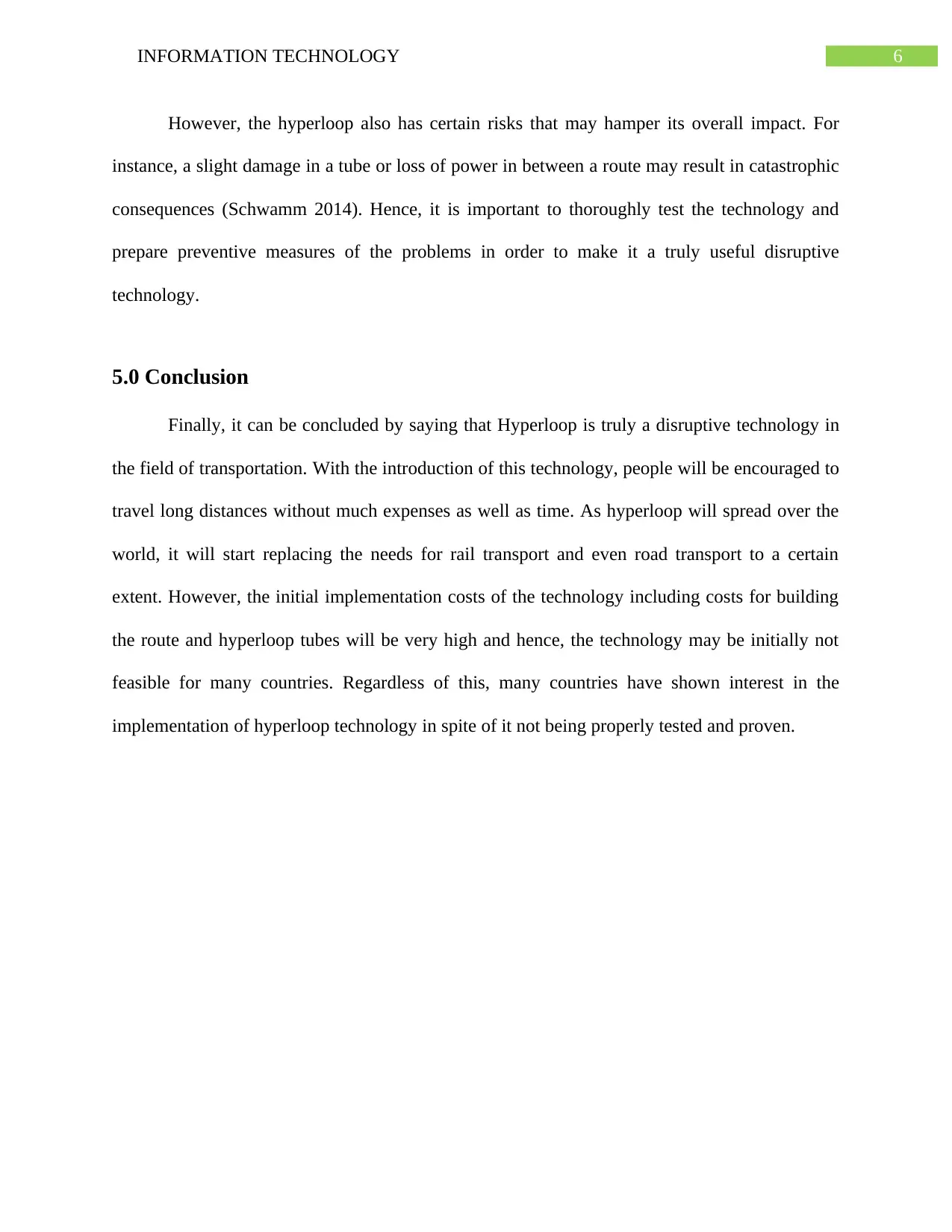
6INFORMATION TECHNOLOGY
However, the hyperloop also has certain risks that may hamper its overall impact. For
instance, a slight damage in a tube or loss of power in between a route may result in catastrophic
consequences (Schwamm 2014). Hence, it is important to thoroughly test the technology and
prepare preventive measures of the problems in order to make it a truly useful disruptive
technology.
5.0 Conclusion
Finally, it can be concluded by saying that Hyperloop is truly a disruptive technology in
the field of transportation. With the introduction of this technology, people will be encouraged to
travel long distances without much expenses as well as time. As hyperloop will spread over the
world, it will start replacing the needs for rail transport and even road transport to a certain
extent. However, the initial implementation costs of the technology including costs for building
the route and hyperloop tubes will be very high and hence, the technology may be initially not
feasible for many countries. Regardless of this, many countries have shown interest in the
implementation of hyperloop technology in spite of it not being properly tested and proven.
However, the hyperloop also has certain risks that may hamper its overall impact. For
instance, a slight damage in a tube or loss of power in between a route may result in catastrophic
consequences (Schwamm 2014). Hence, it is important to thoroughly test the technology and
prepare preventive measures of the problems in order to make it a truly useful disruptive
technology.
5.0 Conclusion
Finally, it can be concluded by saying that Hyperloop is truly a disruptive technology in
the field of transportation. With the introduction of this technology, people will be encouraged to
travel long distances without much expenses as well as time. As hyperloop will spread over the
world, it will start replacing the needs for rail transport and even road transport to a certain
extent. However, the initial implementation costs of the technology including costs for building
the route and hyperloop tubes will be very high and hence, the technology may be initially not
feasible for many countries. Regardless of this, many countries have shown interest in the
implementation of hyperloop technology in spite of it not being properly tested and proven.
Paraphrase This Document
Need a fresh take? Get an instant paraphrase of this document with our AI Paraphraser
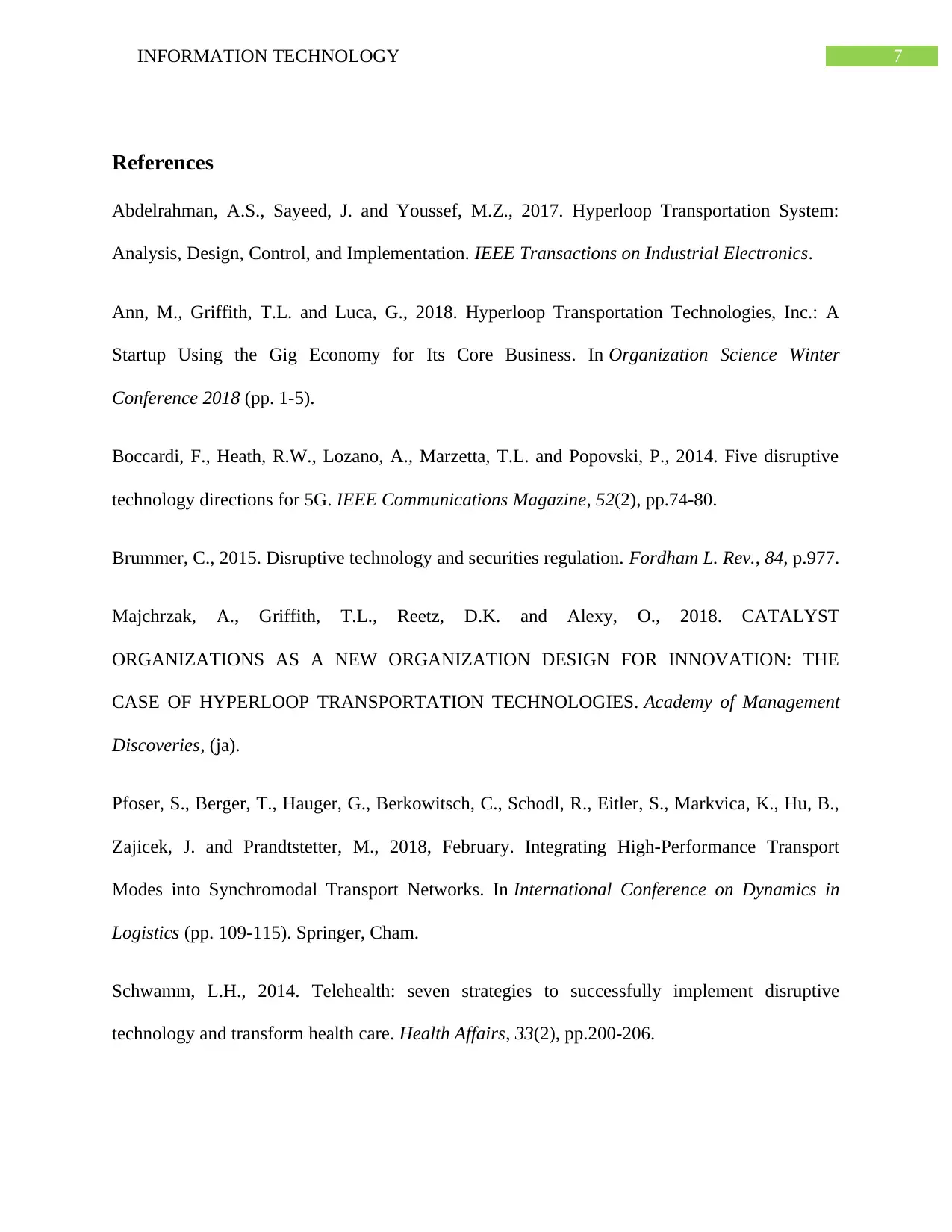
7INFORMATION TECHNOLOGY
References
Abdelrahman, A.S., Sayeed, J. and Youssef, M.Z., 2017. Hyperloop Transportation System:
Analysis, Design, Control, and Implementation. IEEE Transactions on Industrial Electronics.
Ann, M., Griffith, T.L. and Luca, G., 2018. Hyperloop Transportation Technologies, Inc.: A
Startup Using the Gig Economy for Its Core Business. In Organization Science Winter
Conference 2018 (pp. 1-5).
Boccardi, F., Heath, R.W., Lozano, A., Marzetta, T.L. and Popovski, P., 2014. Five disruptive
technology directions for 5G. IEEE Communications Magazine, 52(2), pp.74-80.
Brummer, C., 2015. Disruptive technology and securities regulation. Fordham L. Rev., 84, p.977.
Majchrzak, A., Griffith, T.L., Reetz, D.K. and Alexy, O., 2018. CATALYST
ORGANIZATIONS AS A NEW ORGANIZATION DESIGN FOR INNOVATION: THE
CASE OF HYPERLOOP TRANSPORTATION TECHNOLOGIES. Academy of Management
Discoveries, (ja).
Pfoser, S., Berger, T., Hauger, G., Berkowitsch, C., Schodl, R., Eitler, S., Markvica, K., Hu, B.,
Zajicek, J. and Prandtstetter, M., 2018, February. Integrating High-Performance Transport
Modes into Synchromodal Transport Networks. In International Conference on Dynamics in
Logistics (pp. 109-115). Springer, Cham.
Schwamm, L.H., 2014. Telehealth: seven strategies to successfully implement disruptive
technology and transform health care. Health Affairs, 33(2), pp.200-206.
References
Abdelrahman, A.S., Sayeed, J. and Youssef, M.Z., 2017. Hyperloop Transportation System:
Analysis, Design, Control, and Implementation. IEEE Transactions on Industrial Electronics.
Ann, M., Griffith, T.L. and Luca, G., 2018. Hyperloop Transportation Technologies, Inc.: A
Startup Using the Gig Economy for Its Core Business. In Organization Science Winter
Conference 2018 (pp. 1-5).
Boccardi, F., Heath, R.W., Lozano, A., Marzetta, T.L. and Popovski, P., 2014. Five disruptive
technology directions for 5G. IEEE Communications Magazine, 52(2), pp.74-80.
Brummer, C., 2015. Disruptive technology and securities regulation. Fordham L. Rev., 84, p.977.
Majchrzak, A., Griffith, T.L., Reetz, D.K. and Alexy, O., 2018. CATALYST
ORGANIZATIONS AS A NEW ORGANIZATION DESIGN FOR INNOVATION: THE
CASE OF HYPERLOOP TRANSPORTATION TECHNOLOGIES. Academy of Management
Discoveries, (ja).
Pfoser, S., Berger, T., Hauger, G., Berkowitsch, C., Schodl, R., Eitler, S., Markvica, K., Hu, B.,
Zajicek, J. and Prandtstetter, M., 2018, February. Integrating High-Performance Transport
Modes into Synchromodal Transport Networks. In International Conference on Dynamics in
Logistics (pp. 109-115). Springer, Cham.
Schwamm, L.H., 2014. Telehealth: seven strategies to successfully implement disruptive
technology and transform health care. Health Affairs, 33(2), pp.200-206.
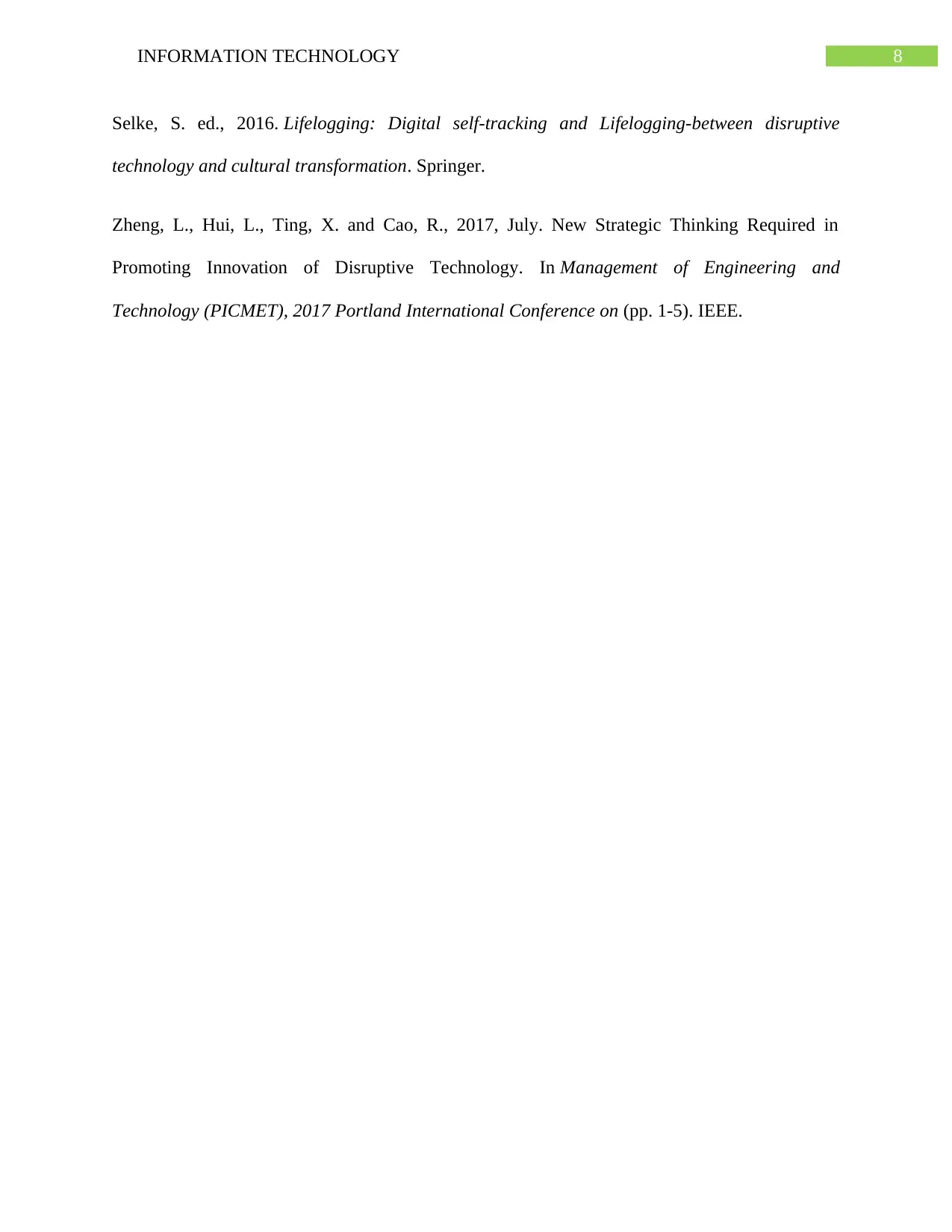
8INFORMATION TECHNOLOGY
Selke, S. ed., 2016. Lifelogging: Digital self-tracking and Lifelogging-between disruptive
technology and cultural transformation. Springer.
Zheng, L., Hui, L., Ting, X. and Cao, R., 2017, July. New Strategic Thinking Required in
Promoting Innovation of Disruptive Technology. In Management of Engineering and
Technology (PICMET), 2017 Portland International Conference on (pp. 1-5). IEEE.
Selke, S. ed., 2016. Lifelogging: Digital self-tracking and Lifelogging-between disruptive
technology and cultural transformation. Springer.
Zheng, L., Hui, L., Ting, X. and Cao, R., 2017, July. New Strategic Thinking Required in
Promoting Innovation of Disruptive Technology. In Management of Engineering and
Technology (PICMET), 2017 Portland International Conference on (pp. 1-5). IEEE.
⊘ This is a preview!⊘
Do you want full access?
Subscribe today to unlock all pages.

Trusted by 1+ million students worldwide
1 out of 9
Your All-in-One AI-Powered Toolkit for Academic Success.
+13062052269
info@desklib.com
Available 24*7 on WhatsApp / Email
![[object Object]](/_next/static/media/star-bottom.7253800d.svg)
Unlock your academic potential
Copyright © 2020–2025 A2Z Services. All Rights Reserved. Developed and managed by ZUCOL.
